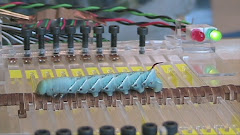A lot has happened in the past few weeks. Besides my secondary injury during my recovery of my bone fracture, everything else seems to progress in a positive direction.
First of all, my paper on caterpillar ground reaction forces was finally printed. It's been really over-due for a year now. Most data were collected by Christmas 2008, and I actually presented the major finding at the SICB 2009 January. I felt pretty bad about this delay but the robotics project last year really took my life from March through October. To summarize the findings in a few sentences: large caterpillars such as
Manduca sexta load their bodies in constant tension when they are attached to a substrate. Locomotion was achieved by progressing the body tension/deformation forward. Biomechanically speaking, these critters use the substrate as their external skeletons. We call this strategy:
environmental skeleton. For more details on this radical view of soft-bodied animal body control, check out the
April 1st issue of the Journal of Experimental Biology. If you would like a PDF copy of my paper, simply e-mail me at huai-ti.lin@tufts.edu and I will gladly send you one.
Besides my old new paper, I've been planning a field trip to Costa Rica for this May and June. Last spring at the SICB conference, I bought a few books about caterpillars. Among them, I was really impressed by a couple of books regarding tropical caterpillar diversity. So I contacted the authors Dr. Daniel Janzen
et al and was struck by the idea of visiting the home of caterpillars in the wild. Lab animals are always somewhat unnatural. This idea was incubated in the back of my mind for many months until I finally formulated it into a more concrete field study project. My mentor Dr. Barry Trimmer was very supportive of the idea and quickly decided to make it happen. In any case, we have now arranged a 17 days field work at a conservation in Santa Rosa, collaborating with Dr. Janzen's team from UPenn.
Finally, to continue the imaging theme from last time, let me share a few images from our histology for
Manduca caterpillars. Working together with my great undergraduate lab-mate Dan, we've been able to produce very clean cross-sections of caterpillar abdomens.

Through some imaging techniques, we can enhance the cuticular folds.

Or we can also highlight the muscles! So awesome... the biology I mean (but we're not bad either)

 Folks in the field of animal locomotion would know how kinematics data are usually obtained. But allow me to summary the general procedure in a few sentences. To track anything in 3D, at least two camera views have to be available at all time. After space calibration, one can calculate the 3D configurations of the objects in the analysis software of his/her choice. Ideally, video tracking can use any inherent features of the subject. However, to facilitate automatic tracking, high contrast makers are often attached to the subject. Infrared markers offer a way to highlight the features of interest without compromising the lighting for the normal video acquisition. After I created two families of soft-bodied robots, I was challenged by the need of quantitative data. These kinematics data are critical for any mechanical analysis on the robot locomotion.
Folks in the field of animal locomotion would know how kinematics data are usually obtained. But allow me to summary the general procedure in a few sentences. To track anything in 3D, at least two camera views have to be available at all time. After space calibration, one can calculate the 3D configurations of the objects in the analysis software of his/her choice. Ideally, video tracking can use any inherent features of the subject. However, to facilitate automatic tracking, high contrast makers are often attached to the subject. Infrared markers offer a way to highlight the features of interest without compromising the lighting for the normal video acquisition. After I created two families of soft-bodied robots, I was challenged by the need of quantitative data. These kinematics data are critical for any mechanical analysis on the robot locomotion. This works out really great for my application because I do not need to worry about IR light flooding or bad camera focus. These surface mount IR emitters produce point-source lighting smaller than 1mm. The IR cameras pick them up like many distant stars. In fact, a little out of focus actually increase the pixel numbers from which the centroid positions are derived.
This works out really great for my application because I do not need to worry about IR light flooding or bad camera focus. These surface mount IR emitters produce point-source lighting smaller than 1mm. The IR cameras pick them up like many distant stars. In fact, a little out of focus actually increase the pixel numbers from which the centroid positions are derived. Data are coming alright, but my data crunching techniques are still too slow for the rate by which these high speed cameras acquire data. I better work on that!
Data are coming alright, but my data crunching techniques are still too slow for the rate by which these high speed cameras acquire data. I better work on that!





.jpg)